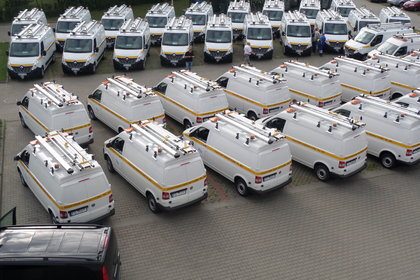Over 140 new energy emergency cars in Enea Operator
Enea Operator invests in the energy emergency fleet. This year, the company will hand over over 250 new cars for field teams, of which over a half is energy emergency cars. On 24 August, Piotr Florek, the Wielkopolskie province governor and Michał Jarczyński, the president of Enea Operator, handed the keys to new cars to energy stations' workers.
Tempests, which did not save the north-western Poland in the summer, i.e. the area of Enea Operator's operations, demonstrated how important a reliable operation of energy emergency teams in the field is. Therefore, the company, caring for a constant improvement in the rendered services invests in the fleet for the energy emergency services. This year, over 140 new emergency cars will go in the field which will facilitate electrical fitters to reach damaged devices and works to restore the power supply.
We have to be prepared to respond to the grid failures which often accompany sudden tempests and storms. The acquisition of new cars for energy stations allows to look optimistically on the preparation of the company to the realisation of these tasks- said the Wielkopolskie province governor, Piotr Florek.
The current civilisation is based on the technique and the power which drives the civilisation is electricity. Without power –it is practically impossible to function – said president Jarczyński. It depends on the quickness of failure repair, on the ability to react swiftly it depends how fast we will act, and how fast we will be able to restore a damaged power grid and restore energy supplies to our Customers – he added.
The cars were tailor-made according to the specific role they will play and their equipment considerably differs from the standard one. A specific fitting was used in the cars. They are equipped with additional external LED lighting, rear view cameras, protection bars allowing driving in challenging terrains and winches. Additionally, some cars have a four wheel drive and a possibility of blocking the rear differential, which has a significant meaning for the teams servicing rural and forest areas where the access to damaged devices takes frequently longer than the repair itself.
Share on:











